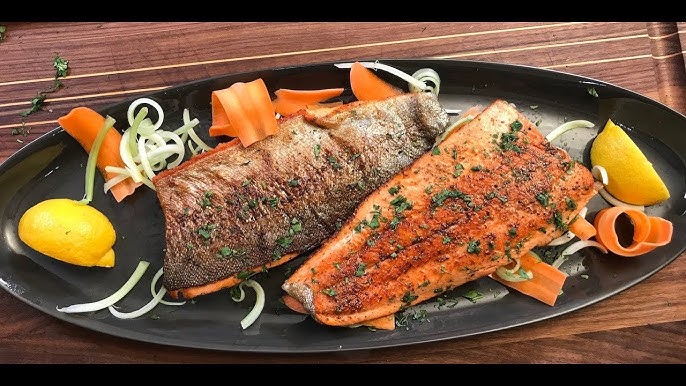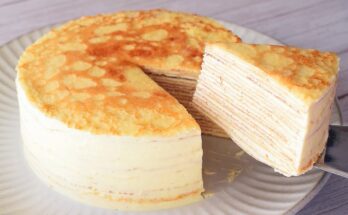Baked Trout Recipe: There’s something special about cooking a whole trout in the oven. The aroma that fills the kitchen, the crispy skin, and the tender, flavorful flesh make it a dish worth mastering. Trout is one of those versatile fish that doesn’t need too much effort—it naturally has a delicate, slightly nutty flavor that pairs beautifully with citrus, herbs, and light seasoning. Unlike some oily fish, trout has a mild taste, which makes it an excellent choice even for those who don’t usually enjoy seafood.
One of the main reasons baked trout is so popular is its health benefits. It’s packed with Omega-3 fatty acids, lean protein, and essential vitamins like B12 and D. Compared to fried fish, baking requires little to no oil, which makes it a heart-healthy option without sacrificing flavor. Whether you’re planning a quick weeknight dinner or preparing a fancy meal for guests, baked trout can be your go-to dish.
It’s also incredibly flexible when it comes to flavors. Want a classic Mediterranean vibe? Add olive oil, garlic, lemon, and parsley. Prefer something bold? Try paprika, chili flakes, and fresh herbs. The best part is—it takes minimal effort and time. In less than 30 minutes, you can have a beautifully baked trout ready to serve.
In this step-by-step guide, I’ll walk you through everything you need to know—from choosing the freshest trout to seasoning, baking, and serving. By the end, you’ll not only have a great recipe but also the confidence to make it again and again, experimenting with flavors to suit your taste.
Ingredients You’ll Need
The magic of baked trout lies in its simplicity. You don’t need a long list of complicated ingredients—just fresh fish and a few pantry staples. Here’s what you’ll need for a classic baked trout recipe:
Essential Ingredients
- Fresh whole trout (1–2 medium-sized fish, cleaned and gutted)
- Lemon slices (for stuffing and garnishing)
- Fresh herbs (parsley, dill, thyme, or rosemary work well)
- Olive oil or melted butter
- Garlic cloves (sliced or minced)
- Salt and black pepper (to taste)
Optional Additions for Extra Flavor
- Paprika or chili flakes (for a spicy kick)
- Sliced onions or shallots
- Cherry tomatoes for roasting alongside the fish
- Capers for a tangy burst
- A splash of white wine
How to Choose the Best Trout
When it comes to trout, freshness is key. Look for fish with bright, clear eyes, shiny skin, and a mild, fresh scent (not fishy). If buying fillets, check that they’re firm and not watery. Farmed rainbow trout is widely available and works great for baking, but if you can get fresh wild trout, the flavor is even better.
Keep in mind that trout cooks quickly, so you don’t want an overly large fish unless you’re serving multiple people. A 1 to 1.5-pound trout is perfect for two servings.
Kitchen Tools and Equipment
You don’t need fancy gadgets to bake trout—just the basics. Having the right tools, however, can make the process smoother and the results more professional.
Essential Kitchen Tools
- Baking dish or sheet pan: A glass or ceramic dish helps keep the fish moist, while a sheet pan allows for crispier skin.
- Sharp knife: For cleaning, trimming fins, or making shallow cuts for seasoning.
- Cutting board: A sturdy surface for prepping the fish and slicing vegetables.
- Aluminum foil or parchment paper: Useful for wrapping the trout if you prefer steaming inside the oven.
- Tongs or spatula: To carefully lift and serve the baked trout without breaking it.
Optional Tools for Better Results
- Fish scaler: Handy if your trout isn’t pre-cleaned.
- Cooking brush: For evenly coating olive oil or butter.
- Meat thermometer: To ensure the fish is perfectly cooked (internal temp should reach 145°F / 63°C).
Having everything prepped before you start baking makes the cooking process much more enjoyable and efficient.
Step-by-Step Guide to Preparing Baked Trout
Let’s dive into the actual cooking process. Baking trout is simple, but paying attention to small details makes a big difference in the final taste and texture.
Step 1 – Cleaning and Preparing the Trout
If you purchased trout that hasn’t been cleaned yet, don’t worry—it’s easy to do at home. First, rinse the fish under cold running water. Use a fish scaler or the back of a knife to gently remove any scales, moving from tail to head. If the fish is already scaled, you can skip this step.
Next, make a shallow cut along the belly of the trout from the gills to the tail, and carefully remove the innards. Rinse the cavity thoroughly to remove any residue, then pat the fish dry with paper towels. Drying is important because excess moisture can prevent the skin from crisping up.
At this stage, you can also trim off any fins with kitchen scissors for a cleaner look. Some people like to score the skin by making shallow diagonal cuts—this not only looks professional but also helps the seasoning penetrate deeper into the flesh.
Once prepped, your trout is ready for seasoning.
Step 2 – Seasoning the Trout
The seasoning is where the trout really comes alive. Start by rubbing the fish inside and out with a little olive oil or melted butter. This keeps the skin from drying out and helps the herbs stick.
Sprinkle salt and pepper generously over the skin and inside the cavity. Then, stuff the cavity with lemon slices, garlic cloves, and a handful of fresh herbs like parsley or dill. The citrus infuses the trout with a fresh brightness, while the herbs add depth of flavor.
If you prefer stronger flavors, try adding paprika, chili flakes, or a drizzle of soy sauce. You can also marinate the fish for 30 minutes before baking, though it’s not strictly necessary since trout absorbs flavors quickly.
At this point, your trout is fully seasoned and ready to hit the oven.
Step 3 – Preheating the Oven
Before sliding your trout into the oven, you need to preheat it. This step may seem minor, but it makes a world of difference in cooking. A preheated oven ensures even heat distribution, meaning your trout will cook consistently from edge to center. Without it, the fish might end up half-done in some areas and overcooked in others.
For baked trout, the ideal oven temperature is 375°F (190°C). At this heat level, the fish cooks gently, retaining moisture while allowing the skin to crisp up. If you’re using foil to wrap your trout, the steam inside will cook it slightly faster, so keep that in mind when timing.
While the oven heats up, double-check that your baking dish is ready. If you want easy cleanup, line the dish with parchment paper or foil. You can also lightly oil the surface to prevent sticking. Place any extra vegetables—like cherry tomatoes, onions, or sliced zucchini—around the fish to bake alongside. This way, you’ll have a full meal ready in one go.
Remember: don’t rush this step. Preheating is the secret to ensuring your trout comes out perfectly baked every single time.
Step 4 – Baking the Trout
Now comes the exciting part—baking your trout to perfection. Place the seasoned fish in your prepared baking dish or on a lined sheet pan. If you stuffed the cavity with herbs and lemon, the aroma will start to build as soon as it enters the oven.
The general rule for baking fish is 10 minutes per inch of thickness at 375°F. For an average whole trout, this usually means about 20–25 minutes. If you’re cooking a larger trout, you may need closer to 30 minutes.
How do you know it’s done? The flesh should be opaque and flake easily with a fork. If you’re using a thermometer, the internal temperature should read 145°F (63°C). Another sign: the eyes of the fish will turn white and the fins should pull away easily.
You can choose between two baking styles:
- Open baking: Leaves the skin crisp and slightly golden.
- Foil-wrapped baking: Traps moisture, creating a steaming effect for extra-tender flesh.
Both methods work wonderfully—it really depends on whether you prefer crisp skin or maximum juiciness.
Once baked, let the trout rest for about 3–5 minutes before serving. This short resting time helps the juices redistribute, keeping the flesh moist.
Step 5 – Serving the Baked Trout
Serving baked trout is all about balance—presentation, flavor, and sides that complement rather than overpower. Begin by carefully transferring the fish to a serving platter using a spatula. If you baked multiple fish, arrange them neatly for an impressive table display.
For garnish, fresh herbs like parsley, dill, or chives add a burst of color and freshness. A squeeze of lemon just before serving brightens the flavor even more. If you want to elevate the dish, drizzle a simple sauce like garlic butter, lemon herb sauce, or a light vinaigrette over the fish.
When it comes to side dishes, baked trout pairs well with almost anything. For a light and healthy meal, serve it with a green salad, roasted vegetables, or steamed asparagus. If you want something more filling, pair it with buttery mashed potatoes, wild rice, or even a simple pasta tossed with olive oil and herbs.
And here’s a small tip: if serving whole trout feels intimidating, you can gently remove the backbone and present it as fillets. This makes it easier for guests to enjoy without dealing with bones.
At the end of the day, baked trout is not just about taste—it’s about creating a meal that feels special. Whether it’s a casual family dinner or a festive occasion, this dish delivers elegance with minimal effort.
Tips for Perfectly Baked Trout
Cooking trout may be simple, but getting it just right every time requires a few tried-and-true tricks. Even seasoned home cooks can run into common problems like dry fish, bland flavors, or uneven cooking. Here are some expert tips that will help you bake trout like a pro.
1. Don’t Overcook the Fish
The number one mistake people make with trout (and fish in general) is leaving it in the oven too long. Because trout has delicate flesh, it cooks quickly and can dry out if not monitored. Stick to the “10 minutes per inch” rule and always check a few minutes before the timer goes off. Once the flesh flakes easily, it’s done—don’t wait longer.
2. Use Fresh Ingredients
The beauty of trout lies in its mild, natural flavor. Fresh herbs, real lemon juice, and quality olive oil make a huge difference. Avoid bottled lemon juice or dried herbs if possible—they simply don’t provide the same brightness.
3. Season Inside and Out
Many people only season the outside of the fish, but the cavity is where you can really infuse flavor. Stuffing it with herbs, garlic, and citrus ensures every bite is aromatic and tasty.
4. Keep the Skin On
Even if you don’t plan to eat the skin, bake the trout with it. The skin acts as a natural barrier, locking in moisture and protecting the delicate meat. If you like crispy skin, bake the fish uncovered with a light brush of olive oil.
5. Add a Splash of Liquid
To prevent the fish from drying, consider adding a small splash of white wine, broth, or lemon juice to the baking dish. This creates steam and enhances flavor.
6. Rest Before Serving
Just like with steak, letting trout rest for a few minutes before serving allows the juices to redistribute, keeping the meat moist and tender.
By following these tips, you’ll not only avoid common pitfalls but also consistently produce trout that looks and tastes like a restaurant-quality dish.
Variations of Baked Trout Recipe
One of the best things about baked trout is how versatile it is. You can easily switch up the flavors to match your mood, the season, or the ingredients you have on hand. Below are some delicious variations you can try:
1. Lemon Garlic Trout
This is the classic version most people know and love. Simply stuff the trout with lemon slices, garlic cloves, and parsley, then drizzle with olive oil. The result is light, fresh, and bursting with flavor.
2. Spicy Baked Trout
If you like heat, this variation is perfect. Rub the trout with olive oil, sprinkle chili flakes or cayenne pepper inside and out, and add a pinch of smoked paprika for depth. A squeeze of lime instead of lemon gives it a zesty kick.
3. Herb Butter Trout
For a richer flavor, mix softened butter with chopped herbs like dill, thyme, and chives. Spread this mixture inside the cavity and on top of the fish before baking. The butter melts into the trout, creating a luscious, savory result.
4. Mediterranean-Style Trout
Think olives, capers, tomatoes, and oregano. Stuff the fish with lemon and herbs, then scatter olives, capers, and cherry tomatoes around the baking dish. The juices mingle together, creating a vibrant, Mediterranean-inspired meal.
5. Asian-Inspired Trout
For a fusion twist, marinate the fish in soy sauce, ginger, garlic, and a touch of sesame oil before baking. Garnish with green onions and sesame seeds for a dish full of umami.
With these variations, you can turn the same basic recipe into something new and exciting every time you make it.
Health Benefits of Eating Trout
Beyond its delicious flavor, trout is a nutritional powerhouse. Including it in your diet regularly can support overall health and well-being. Let’s break down why this fish is such a great choice.
1. Rich in Omega-3 Fatty Acids
Trout is packed with heart-healthy Omega-3s, which reduce inflammation, lower blood pressure, and support brain health. Unlike some fatty fish, trout has a mild flavor, making it a more approachable source of these essential fats.
2. High in Protein
Protein is crucial for muscle repair, energy, and satiety. A serving of trout provides around 20 grams of protein, making it an excellent option for athletes, fitness enthusiasts, or anyone looking to stay full longer.
3. Low in Calories but Nutrient-Dense
Compared to red meat or fried foods, baked trout is low in calories while being rich in vitamins and minerals. It’s particularly high in vitamin B12, vitamin D, and selenium, all essential for energy, bone health, and immune function.
4. Great for Weight Management
Because it’s lean, filling, and low in unhealthy fats, trout is ideal for anyone trying to manage their weight. Paired with veggies or whole grains, it makes for a balanced, satisfying meal.
5. Supports Brain and Heart Health
The Omega-3s and antioxidants in trout are proven to support cognitive function and cardiovascular health. Regular consumption may lower the risk of heart disease and cognitive decline as we age.
So, when you enjoy a plate of baked trout, you’re not just treating your taste buds—you’re also nourishing your body in the best way possible.
FAQs about Baked Trout Recipe
1. Can you bake frozen trout?
Yes, but it’s best to thaw it first for even cooking. If baking from frozen, add extra cooking time and cover with foil to prevent drying.
2. How do you store leftover baked trout?
Store it in an airtight container in the fridge for up to 3 days. You can reheat it gently in the oven at a low temperature or flake it cold into salads.
3. Can trout be baked without foil?
Absolutely! Baking uncovered gives you crispier skin, while foil keeps it moist. It depends on your preference.
4. What’s the best wine pairing with baked trout?
A crisp white wine like Sauvignon Blanc, Pinot Grigio, or Chardonnay pairs beautifully with trout’s delicate flavors.
5. Can you eat the trout skin?
Yes! Trout skin is safe and delicious when baked crispy. Many people enjoy it for its texture and flavor.
Conclusion
Baked trout is the perfect example of how simple ingredients can create an extraordinary dish. With just a few fresh herbs, a squeeze of lemon, and the right baking method, you can turn this humble fish into a meal that’s healthy, satisfying, and full of flavor.
Whether you stick to the classic lemon-garlic version or experiment with spicy, herb butter, or Asian-inspired twists, baked trout is a recipe worth mastering. Not only is it easy and quick, but it also brings impressive results every time.
So, the next time you’re looking for a wholesome dinner idea, give baked trout a try—you’ll be surprised at how effortless and rewarding it is.



